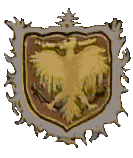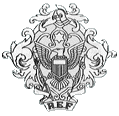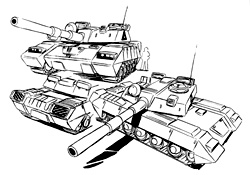

Designation:M-21 (-21A1) Anaconda Heavy Tank |

| 
|

|
||

|
|||||



The armor on the front of the Anaconda is composed of a standard Chobham laminar reinforced by a heavy depleted Uranium mesh on the outer plate. More dense than the standard Chobham, this armor was designed to defeat projectiles striking the forward surfaces of main battle vehicles, and is also effective against beam weapons. The armor stops all small arms, heavy infantry weapons fire, and light mecha-mounted weaponry, provides excellent resistance to medium mecha-mounted weaponry and provides good resistance to heavy mecha-mounted weaponry, such as the Centaur's 120mm smoothbore shells. This impressive front armor was second only to the Monster's armor in effectiveness, leading combatants to try to target this tank from the sides and rear at all costs.
The armor on the rest of the M-21 is composed of a standard Chobam laminar developed in the late 20th century and improved with the materials science advances made during the Robotech era. This armor was mainly designed to defeat projectiles and other kinetic weapons. The armor stops all small arms, heavy infantry weapons fire, and light mecha-mounted weaponry, and provides excellent resistance to medium mecha-mounted weaponry, such as the Valkyrie's 55mm APFSDS round, and fair resistance to heavy mecha-mounted weaponry, such as the Centaur's 120mm smoothbore shells.
The Anaconda provides full protection from nuclear, biological, and chemical hazards, using an overpressure cockpit environment activated by radiation and hazardous chemical sensors, or manually when biological warfare conditions are anticipated. The internal consumables supplies can provide atmosphere for one week maximum.
The M-21 Anaconda was developed by the Robotech Defense Force as a research platform for advanced armor materials to be used on the destroid series under development. The M-21 used more advanced materials to drastically increase the armor capability of the tank to improve its battlefield survivability.
Near the end of 2012, the Southern Cross command decided to increase the capabilities of their arsenal without arousing the interest of the RDF high command which kept a watchful eye on any protoculture development. They believed this would decrease their reliance upon the UEG government they no longer fully trusted. As such, the Southern Cross adopted a number of conventional military vehicles that did not rely heavily on the tightly monitored technological advances that came from the SDF-1, Robotech Factory Satellite and Zentraedi armada, and used the unrest caused by the discontent Zentraedi as an excuse for the military build-up. The M-21 Anaconda was one of these vehicles, which they used effectively to coerce other communities into joining into their mutual defense organization. These vehicles were significantly cheaper than any veritechs allowing the Southern Cross to field a significant army. This army led the Southern Cross to be the dominant power when the REF departed for Tirol as non-aligned communities could not mount sufficient resistance to maintain their independence.
In 2018, as the UNDF was dissolving and transferring its military assets to the ASC and REF, the ASC was slated to receive the more conventional weapons platforms including all M-21s and their variants. As such in 2020, the ASC weapons development section developed the M-21A1 using the successful M2018 cannon used by the more advanced VHT-1 hovertank.
The Anaconda is a conventional tank that makes use of improved materials technology to provide an extremely well-armored assault platform. With the knowledge gained from the SDF-1, materials technology made drastic advances related to the structures needed for variable technology mecha. In a lower risk implementation, these materials were applied to existing technology to increase the armor and significantly reduce the weight of the modern tanks. In a joint venture by Krupp MaK Maschnenbau GmbH of Germany and Mitsubishi Heavy Industries of Japan, the Anaconda was developed. The lighter weight, corresponding increase in speed, and ability to withstand a frontal attack by standard anti-tank weapons makes the Anaconda a significant breakthrough in armored combat for its time. This tank used a liquid-propelled upgrade of the successful 120mm cannon used on the M1A1 Abrams and Leopard 2 tanks, and added an autoloader to decrease the crew complement and increase the rate of fire.
For survivibility, the ammunition compartment for the main gun has a blast door on the top of the turret similar to the M1A1 Abrams and Leopard 2 tanks, so if the ammo is ignited, it will blow out the top of the tank instead of inside the turret killing the crew. The tank also has an internal fire detection and suppression system.
The success of the Commanchero heavy attack helicopter led the designers to include some air defense missiles in the design to improve the survivability of the tank. Southern Cross tank crews began referring the [Stinger II] missiles as "Commanchero-killers" after their successful use in a battle near Buenos Aires with a rogue RDF unit. The Commancheros were able to decimate the ranks of ancient Leopard 2 and Abrams tanks, but the Anacondas faired well in the exchange.
A number of versions were developed including an armored recovery vehicle, a minesweeper, a bulldozer and an armored command post.
Return to RDF Vehicles Index
Go to Robotech Reference Guide Home Page.
Robotech (R) is the property of Harmony Gold. This document is in no way intended to infringe upon their rights.
Design and HTML by Robert MorgensternCopyright © 1997 Robert Morgenstern, Peter Walker, Pieter Thomassen
Last Updated: Sunday, December 14, 1997 6:25 AM